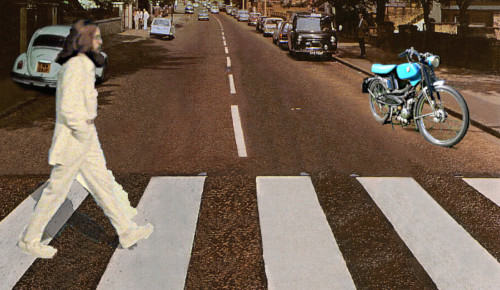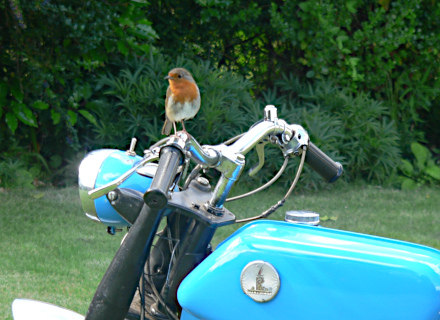Listed from June 1965, the RM12 Super-50 was a ‘surprise’ Raleigh sports moped mainly finished in black with a Neptune Blue fuel tank which sported plastic chrome-effect stick-on knee grips, a 2.67bhp engine, variator transmission and ‘valanced’ telescopic front forks. The 12½-pint capacity fuel tank was a unique Raleigh pressed assembly, which bolted on to the forward frame to look like a motor cycle style top-tank. It was also fitted with a perspex fly screen and drop handlebars, which were simply the normal ‘All-Rounder’ pattern bars turned the other way round, and a dual seat so the rider could more effectively ‘tuck-down’!
For Raleigh, basing its new sports moped upon the same lightweight rigid-rear Runabout frame offered not only a cost advantage, but also gave the slender RM12 a given dry weight of just 102lbs, while the Raleigh RM5 Supermatic weighed in at 112lbs. The comparative and bulkier Motobécane SP50 sports moped with rear swing-arm frame weighed in at a portly 120lb, so an 18lb weight saving was a big difference for the Raleigh Sport-50 moped equipped with the same power unit. Motobécane never produced a comparable equivalent to the RM12.
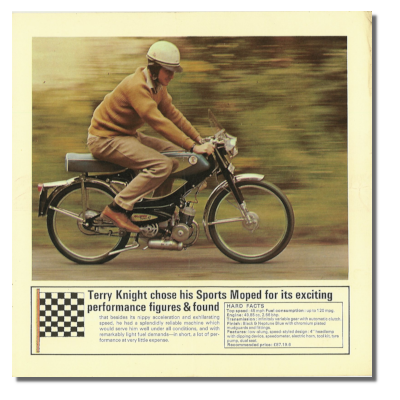
Many aspects of the Super-50 rigid frame, fittings and wheels are different from the swing-arm RM5, though the drive ratios work out closely similar:
RM5 front sprocket 12T / RM12 front sprocket 11T (lower by 8.3%)
RM5 rear sprocket 48T / RM12 rear sprocket 44T (higher by 8.3%)
RM5 rear wheel 18-inch with 2.25 tyre = 22½" diameter / RM12 rear wheel 19" with 2.00 tyre = 23"
So the RM12 final drive ratio is 2.17% higher than RM5, which barely gives an extra 1mph for the same revs at top speed.
Raleigh’s sales brochure posted the RM12 list price at £79–19s–6d, quite reasonable considering its sporting specification, though it cost the customer £87–19s–6d once Purchase Tax had been added.
Nineteen-inch wheels with chrome plated Dunlop Endrick pattern rims were built onto Atom/Prior ribbed full-width alloy hubs, with a 90mm front brake and a 100mm rear.

The dual saddle is finished in turquoise fabric with white piping to match with the Neptune Blue fuel tank and, despite the dual seat, there are no rear footrests fitted, so it was seemingly never intended for use as a two-seater; the longer saddle was only to allow the rider to adopt a lower crouch position. Added sparkle came in the form of chrome-plated mudguards and all mudguard stays, the rear lamp bracket, toolbox covers, and adhesive chrome-effect decals on the side panels. All other cycle parts were black finish.
The AV89 specification motor was 39mm bore × 41.8mm stroke for 49.9cc, with 9:1 compression ratio, rated at 2.67bhp @ 5,600rpm, and fitted with a Gurtner H14mm carburettor.
Tyre pressures were given as front 24psi and rear 41psi (presumably hard pressure for best performance).
Starting could be the usual proven kickstart procedure but, with the stand settled so that both wheels are on the ground, you’re not going to be able to kickstart on the spot—so we’re down to pedalling away on the decompressor for a flying start. If it doesn’t fire up on the throttle alone, then thumb the choke trigger as required to encourage the motor to start. A couple more minor tweaks on the lever quickly find the engine running clear, then we sit warming the motor while our pacer is making ready, because we’re never going to trust whatever a 60mph Huret speedo might be trying to tell us.
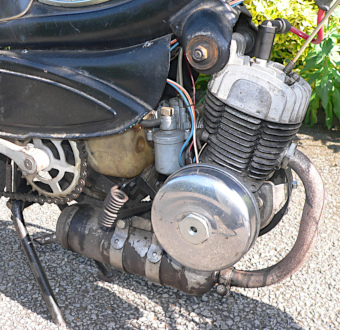
Opening the throttle, the bike pulls cleanly and capably away, readily going through an indicated 30 with lots more twist-grip in reserve. While the performance seems promising, the steering feels a bit twitchy, probably because of the low and narrow handlebars, while the rigid rear quickly impresses that it’s going to be a hard ride.
Glancing back, our pacer is already back in the traffic, so we wait after the roundabout before heading off on the country road. The speedometer becomes difficult to make out beyond the 30-marker at 12 o’clock because it’s a bit obstructed by cables and the viewing angle isn’t clear through the yellowed plastic lens. While the Super-50 seems to readily pull up to around 40 on the dial, it also noticeably fades back against uphill gradients. Following the outrun to get some heat into the motor, we spin in the road for the return run and pretty much hold on full throttle all the way back. While we can only report from a rider’s perspective that the speedo needle was somewhere around the 40mph marker, our pacer clocked off consistent running at 38 on the flat, and best of 42 downhill. Riding position is generally crouched due to the nature of the bike, from which it was still possible to tuck down a little more, but one-handed riding was not advised due to the bumpy road and edgy handling.
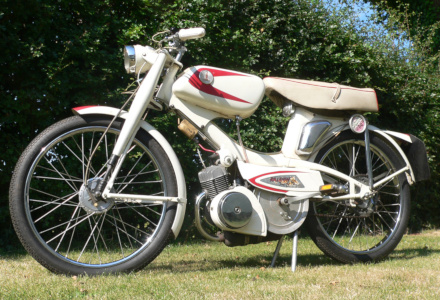
At the same time that its new ‘sister’ RM11 Super Tourist model officially entered production on 1st January 1966, the RM12 colour scheme was changed to a new Pearl Grey with Fire Red trim, and the plastic ‘chrome’ knee grips deleted from the tank. The chrome plated mudguards, stays, and chrome rear lamp bracket were also changed in favour of painted items in the new scheme, though Raleigh stayed with the chrome plated toolbox covers—maybe because the new RM11 employed the very same chrome finish toolbox covers.
This is pretty much the arrangement that our second test bike displays, though we’re not sure that the red flashes on the front mudguard and rear lamp bracket were part of the standard paint scheme, but there may be an explanation for this…
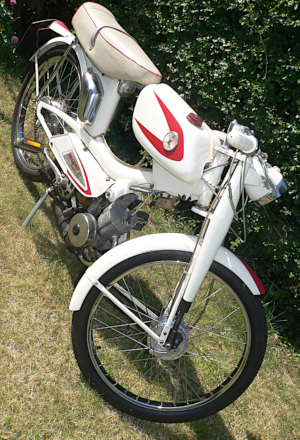
Our bike was registered to Raleigh Industries for the first two years of its life as a display demonstrator that travelled around to promotion events, trade displays, and dealerships in a factory transporter. Brian Aplin said he had photographs of himself standing by this very bike at a Raleigh event, but we have unfortunately been unable to secure these pictures.
The dual saddle is finished in a cream fabric with red piping to match the paintwork colour scheme and, again, there are no rear footrests fitted, so it was never really intended to carry any pillion passenger. The French Luxor 109 headlamp was paired with a British Wipac S446 tail lamp on both of our featured models.
Once again we favour pedalling away on the decompressor for a flying start, and thumbing the choke trigger is the best way to encourage the motor to fire. A couple more minor tweaks on the lever soon find the engine running clear, then we cruise up and down the lane to warm the motor while our pacer is gathering, when we note buzzing and clonking noises coming from the speedometer, and the needle doesn’t move at all. Monsieur Huret seems pretty broken already…
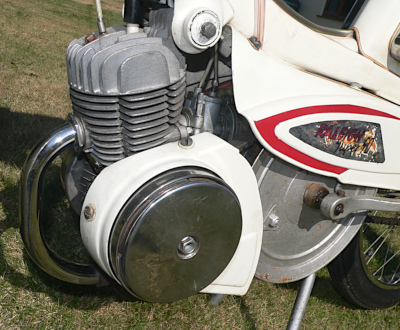
Opening the throttle the bike pulls cleanly and capably away, while the exhaust tone is quiet and smooth. The steering and handling feels tighter and less twitchy than our first machine, so maybe the fork bushing is in better condition, and the foam padding in the seat feels firmer, so it seems to deliver a less aggressive ride.
Taking the same course as our first run, this white example feels to run somewhat smoother but doesn’t build up revs so freely, which is maybe a sign of a recent motor rebuild that hasn’t fully settled in yet. While the motor noticeably fades back against uphill gradients, that’s not unexpected for any 50, which is never going to have anything in reserve. Following the outrun to get some heat into the motor, we spin in the road at the same spot for the return run, and pretty much hold on full throttle all the way back. Our pacer clocked off a best of 40 downhill, which is probably all that really matters on a Sport-50. Riding position is generally crouched due to the nature of the bike, from which it was still possible to tuck down a little more, and since the front-end handling is more stable on this machine, one-handed riding proves a little more confident on the same bumpy roads.
The horn keenly croaks in response to the button, so there’s obviously plenty of power coming from the generator, but switch on the lights and they’re just dim and dismal. We do wonder if the bulb voltages and wattages might be incorrect? They should be 6V × 15W front, and 6V × 3W rear.
The RM11 and RM12 were dropped from the Raleigh range in July 1967.
Obviously there's a bit of folklore about ‘John Lennon owned an RM12’, but did he?
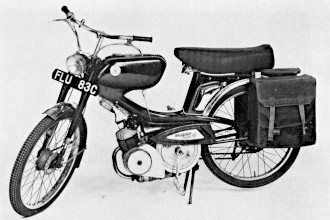
Lot 192
John Lennon was born on 9th October 1940, and the RM12 became available from June 1965.
So why would Lennon want to have an RM12 moped at 25, when the Beatles had already achieved mainstream success in the UK in early 1963, had ‘broken’ America in 1964, received MBEs in the Queen’s Birthday Honours list in 1965, and just released ‘Help’ by the time the RM12 first appeared for sale in June 1965? Would John Lennon go out and buy a moped to celebrate all that?
You may detect some scepticism, so let’s dig a little deeper…
Simple Internet searches on John Lennon quickly bring up information that he was a keen cyclist from his younger years, and is reported to have owned several Raleigh racing bikes. An image search also readily comes up with an old photograph of a Raleigh RM12 fitted with rear panniers, wearing registration FLU 83C, and sold at the first Rock ’n’ Roll memorabilia sale in 1981.
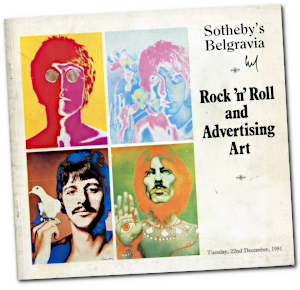
Sotheby’s auction catalogue
Following this lead, we track this back to a Sotheby’s auction catalogue dated 22nd December 1981, Lot 192 estimate: £300/500: a Raleigh Super-50 moped ‘once owned by John Lennon’, the vehicle finished in black with canvas pannier bags, and complete with registration book detailing the ownership of the vehicle by Brian Epstein Automobiles, and then by John Winston Lennon in 1967 and 1968.

FLU 83C’s log book
We further managed to track down a scan of the old VE60 buff log for FLU 83C, recording the first owner as Brydor Cars, Brian Epstein Automobiles, Hanworth Road, Hounslow, Middlesex, and date stamped 24th December 1965. The next entry shows John Winston Lennon, 23 Albemarle Street, London W1, seemingly dated Jan 1967, with a side note ‘Kept in Surrey’.
The RM12 was sold in the 1981 auction to Terry Smith, managing director of Liverpool’s Radio City radio station for £2,000.
This RM12 Super 50 was reportedly bought for John by Brian Epstein (Beatles manager until his death from an accidental drug overdose on 27th August 1967), in 1965 to enable Lennon to get through the London traffic to EMI’s Abbey Road studios on time for recordings and rehearsals.
The same Raleigh RM12 FLU 83C unrestored (with black tank and saddlebags), along with John Lennon’s old driving licence next appeared on display at a Japanese museum dedicated to John Lennon, his life and music, at the Saitama Super Arena in Chūō-ku at Saitama City, Saitama Prefecture, Japan. This bike also visually matches the bike of the same registration number FLU 83C illustrated in the Sotheby’s catalogue of 22nd December 1981.
The John Lennon Museum opened on October 9, 2000, the 60th anniversary of Lennon’s birth, and closed on September 30, 2010, when its exhibit contract with Yoko Ono expired.
Here, the trail goes cold, and what became of the bike is unknown.
